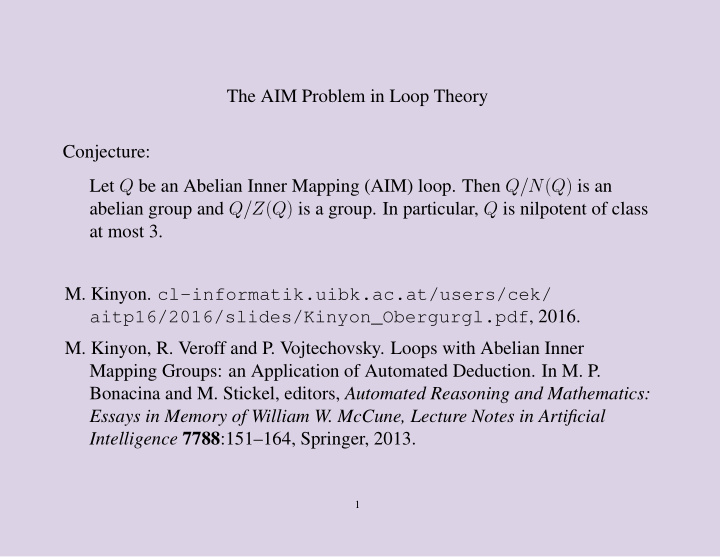



The AIM Problem in Loop Theory Conjecture: Let Q be an Abelian Inner Mapping (AIM) loop. Then Q/N ( Q ) is an abelian group and Q/Z ( Q ) is a group. In particular, Q is nilpotent of class at most 3. M. Kinyon. cl-informatik.uibk.ac.at/users/cek/ aitp16/2016/slides/Kinyon_Obergurgl.pdf , 2016. M. Kinyon, R. Veroff and P. Vojtechovsky. Loops with Abelian Inner Mapping Groups: an Application of Automated Deduction. In M. P. Bonacina and M. Stickel, editors, Automated Reasoning and Mathematics: Essays in Memory of William W. McCune, Lecture Notes in Artificial Intelligence 7788 :151–164, Springer, 2013. 1
AIM Loops (Clauses) % loop axioms 1 * x = x. x * 1 = x. x \ (x * y) = y. x * (x \ y) = y. (x * y) / y = x. (x / y) * y = x. % inner mappings (y * x) \ (y * (x * u)) = L(u,x,y). ((u * x) * y) / (x * y) = R(u,x,y). x \ (u * x) = T(u,x). % abelian inner mapping group T(T(u,x),y) = T(T(u,y),x). L(L(u,x,y),z,w) = L(L(u,z,w),x,y). R(R(u,x,y),z,w) = R(R(u,z,w),x,y). T(L(u,x,y),z) = L(T(u,z),x,y). T(R(u,x,y),z) = R(T(u,z),x,y). L(R(u,x,y),z,w) = R(L(u,z,w),x,y). 2
AIM Conjecture (Clauses) % associator (x * (y * z)) \ ((x * y) * z) = a(x,y,z). % commutator (x * y) \ (y * x) = K(y,x). % goals a(K(x,y),z,u) = 1 # label("aK1"). a(x,K(y,z),u) = 1 # label("aK2"). a(x,y,K(z,u)) = 1 # label("aK3"). K(a(x,y,z),u) = 1 # label("Ka"). a(a(x,y,z),u,w) = 1 # label("aa1"). a(x,a(y,z,u),w) = 1 # label("aa2"). a(x,y,a(z,u,w)) = 1 # label("aa3"). 3
AIM Theory Hierarchy LC C Steiner LCC CC Loop Theory AIM SAIP Moufang left Bol left Bruck 4
The Challenges How far up the loop hierarchy can we prove the conjecture? Although general AIM is the ultimate goal, results in several of the extensions of the theory are new and of significant interest. We also are interested in discovering other, previously unspecified, properties of AIM loops. 5
The Process We boot-strapped the project (for initial sets of hints) by proving the conjecture in strong extensions of the theory for which the result was known (e.g., Moufang loops) On success: move farther up the hierarchy On failure: • Prover9 parameters (but not a lot) • additional and/or different extra assumptions • intermediate lemmas (e.g., suggested by the mathematicians) • looser or different characterization of related theorem • iterative methods (e.g., varying lex order of terms) As the library of proofs grows, it becomes increasingly important to manage hints (selection and prioritization) effectively. 6
Notable Results (Mathematics) • Original goals in extensions of the theory (working up the hierarchy) • Goal equivalences aK1 , aK2 , aK3 and Ka are equivalent (in AIM) aa1 , aa2 , aa3 are equivalent (in AIM) Proving aK2 implies the others was extremely difficult • Previously unknown properties of AIM loops, for example, K(K(x,y),z) = K(x,K(y,z)). a(x,y,z) * K(u,w) = K(u,w) * a(x,y,z). See www.cs.unm.edu/˜veroff/AIM/ . 7
AIM Proof Lengths 2011: 2015: 2017: 2019: 24,356 73,625 242,134 242,134 18,862 69,489 141,589 193,847 17,075 54,742 112,135 141,589 16,400 45,131 89,716 124,938 15,785 40,708 87,534 112,135 Proof levels: Several over 500, one at 841 8
Other Measures of Progress Before hint prioritization: 549 proofs in 117 output files, 167K distinct hint clauses, 47K appearing in more than one output file As of November 2018: 641 proofs in 149 output files, 2.3 million distinct hints, 90K appearing in more than two output files As of January 2019: 660 proofs in 158 output files, 2.6 million distinct hint clauses, 114K appearing in more than two output files 9
Other Projects Lattices, groups, loops, classical and nonclassical logics ... Publications in respected math journals: Algebra Universalis, Journal of Algebra, Transactions of the AMS, Notre Dame Journal of Formal Logic, Studia Logica ... 10
Recommend
More recommend